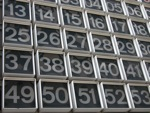 When it comes to memorizing various things, numbers are often considered the toughest challenge. How do you turn something so abstract into something easily imagined, and more importantly, something easily recalled?
When it comes to memorizing various things, numbers are often considered the toughest challenge. How do you turn something so abstract into something easily imagined, and more importantly, something easily recalled?
The most common systems used to remember numbers are the Major/Peg system, which I cover in these links and in these videos. Alternatively, there's also the DOMINIC system.
The major obstacle for most people, however, is that both of these systems require some study on their own before they can be used regularly as a tool. Having said that, those who do put in the work do find them remarkably useful, with the payoff being images for a given number being more readily available.
What if you need to memorize numbers, but not badly enough to study and adopt such as system? There are alternatives that take advantage of what you already know about a given number.
First, there's the Number Shape system, in which you simply remember numbers via objects with a similar appearance:
Not many people are aware that the Wikimedia sites (known mostly for Wikipedia) have an entire section of photos dedicated to the Number Shape system.
In a similar vein, there's the Number Rhyme system:
The system with probably the widest variety of potential for images, at least of the simple systems, would have to be what I call the “conceptual” system. In this approach, you use images that you've related to the number in other parts of your life. In the video below, it initially seems like the lecturer is using the Number Rhyme system, since she uses “sun” as her image for 1 (about 1:30 into the video). However, note that she continues with using “eyes” for 2, and “triangle”. This is, however, a good lesson in feeling free to use other supporting systems, should one not work for you in a particular instance.
Coming up with your own images can be a bit of a challenge for this system, depending on the number and your experience. For example, quick, what image would you use for 32? If you're having trouble coming up with an image, Wikipedia's number pages can be of great help, such as their number page for 32.
Think-a-link, a mnemonic site, also uses this approach, but takes it one step further. In their tips and tricks for numbers section, they take such approaches as splitting up the numbers (using a 4 by 4 for 44), percentages (75 = 75%, possibly a Pac-Man type image), and even Roman numerals (4 = IV, so 4 = ivy).
Looking through this page and other pages on this site with a number you need can be very inspiring. Didn't find an image you could use for 32 at the Wikipedia link? Check out the approaches used in the entries for Franklin D. Roosevelt, Germanium, 4 times 8, and others.
The last simple number system I'll mention in this post has been dubbed by Rememberg.com as the “Count System”, which focuses on the number of letters in common words and phrases. Because of this, it tends to work better for longer numbers. For example, Searching for 32 doesn't bring up any Count System results there, but 320 and 3200 work just fine.
This is not intended as an exhaustive list, but rather as a place to start exploring. Since creativity is so important in creating a mnemonic system, there are many more ways, and many more will be developed. Even at Rememberg, the site I just mentioned, they cover other systems beyond the ones discussed here.
The important thing is to find one that is fun and useful for your needs.
0
Memorizing Numbers
Published on Sunday, November 27, 2011 in fun, innumeracy, memory, self improvement, videos
Related Posts
Post Details
Subscribe to:
Post Comments (Atom)




No Response to "Memorizing Numbers"
Post a Comment